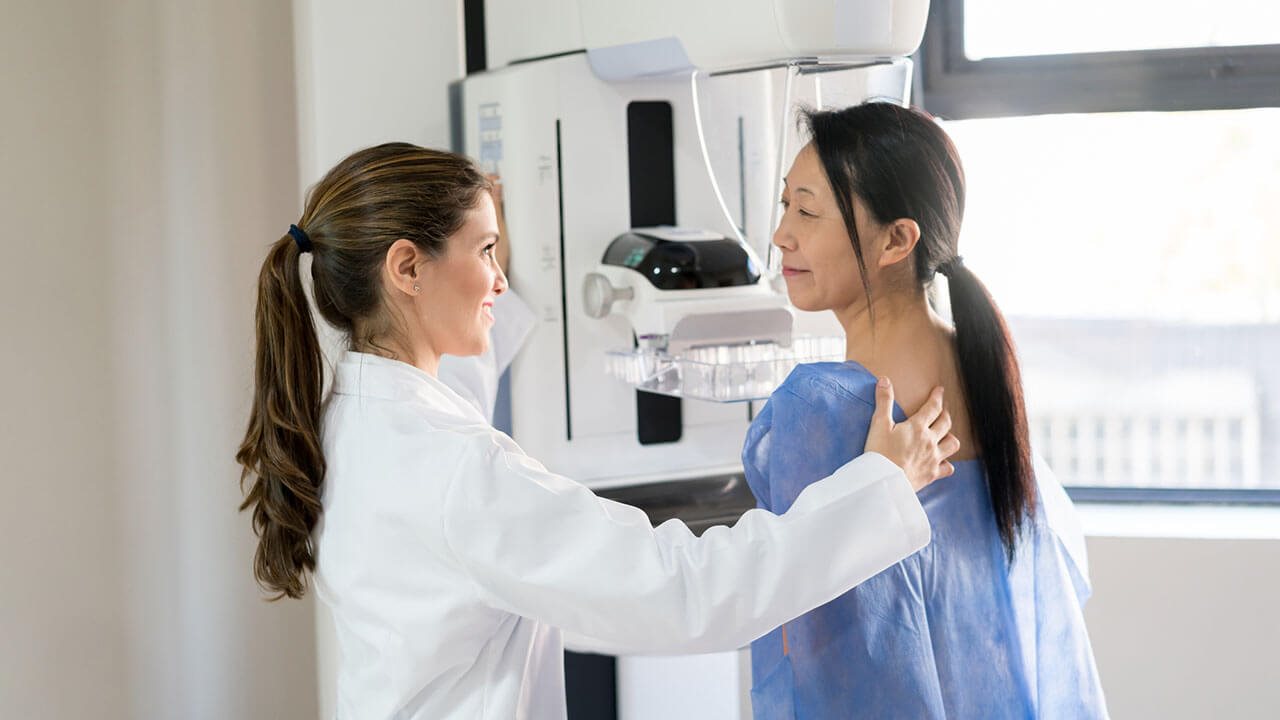

There are several things you can do to keep your breasts healthy. The most important one is to have regular exams, such as a screening mammogram. However, a self-breast exam and clinical breast exam could help to identify any changes in your breasts as well.
All women should talk with their health care provider about the appropriate timing for screening mammograms, especially women who are age 40 or at high-risk. A schedule will be based upon your individual health. At age 40, any woman may wish to begin regular screening mammograms. By age 45, women should have a screening mammogram and continue to have one at least every other year.
Mammography is the gold standard for breast cancer screenings. It is an X-ray system that uses high-contrast, high-resolution, low-dose X-rays designed specifically for detailed pictures of the breasts. It is important to get regular mammograms because breast cancer normally doesn’t show symptoms in its earliest stages. With regular mammograms, breast cancer is more likely caught early, when it is most treatable. Mammograms can even detect some forms of pre-cancer before the development of a tumor. The Food and Drug Administration (FDA) reports that mammography can find 85 to 90 percent of breast cancers in women older than 50 and can discover a lump up to two years before it can be felt – even with regular and careful self-examination.
A breast self-exam is an inspection of your breasts that you do on your own. To help increase your breast awareness, you use your eyes and hands to determine if there are any changes to the look and feel of your breasts. If you notice new breast changes, discuss these with your health care provider. Though most breast changes detected during a self-exam have benign causes, some changes may signal something serious such as breast cancer.
A clinical breast exam (CBE) is a physical exam done by your health care provider. It's often done during your annual medical check-up. The provider will visually check your breasts while you are sitting up and physically examine your breasts while you are lying down. If a CBE is not offered at your check-up and you would like one, ask your health care provider if he or she can perform one. If they cannot, they will refer you to someone who can. For most women, a clinical breast exam will find no signs of breast cancer. If your exam does find something abnormal, you’ll need follow-up tests to check whether or not the finding is breast cancer.
Together, let’s beat the odds! Get screened. But remember, every woman’s needs and wishes are different. Talk to your provider about when you should begin screenings and to get all your questions answered.
To schedule a mammogram call (920) 496-4789
What is a screening mammogram and when should I have one?
Screening mammograms are routine mammograms for women with no breast changes or concerns. Multiple images of the breast are taken and the entire process takes approximately 20 minutes. The goal of a screening mammogram is to detect breast cancer when it is too small to be felt by you or your health care provider. If a routine mammogram indicates an abnormality, further breast imaging, such as a diagnostic mammogram, ultrasound or MRI may be recommended.All women should talk with their health care provider about the appropriate timing for screening mammograms, especially women who are age 40 or at high-risk. A schedule will be based upon your individual health. At age 40, any woman may wish to begin regular screening mammograms. By age 45, women should have a screening mammogram and continue to have one at least every other year.
Mammography is the gold standard for breast cancer screenings. It is an X-ray system that uses high-contrast, high-resolution, low-dose X-rays designed specifically for detailed pictures of the breasts. It is important to get regular mammograms because breast cancer normally doesn’t show symptoms in its earliest stages. With regular mammograms, breast cancer is more likely caught early, when it is most treatable. Mammograms can even detect some forms of pre-cancer before the development of a tumor. The Food and Drug Administration (FDA) reports that mammography can find 85 to 90 percent of breast cancers in women older than 50 and can discover a lump up to two years before it can be felt – even with regular and careful self-examination.
Other ways to keep your breasts healthy
Many women may find it comforting to perform other exams in between regular mammogram screenings. Such exams include breast self-exam and a clinical exam.A breast self-exam is an inspection of your breasts that you do on your own. To help increase your breast awareness, you use your eyes and hands to determine if there are any changes to the look and feel of your breasts. If you notice new breast changes, discuss these with your health care provider. Though most breast changes detected during a self-exam have benign causes, some changes may signal something serious such as breast cancer.
A clinical breast exam (CBE) is a physical exam done by your health care provider. It's often done during your annual medical check-up. The provider will visually check your breasts while you are sitting up and physically examine your breasts while you are lying down. If a CBE is not offered at your check-up and you would like one, ask your health care provider if he or she can perform one. If they cannot, they will refer you to someone who can. For most women, a clinical breast exam will find no signs of breast cancer. If your exam does find something abnormal, you’ll need follow-up tests to check whether or not the finding is breast cancer.
Together, let’s beat the odds! Get screened. But remember, every woman’s needs and wishes are different. Talk to your provider about when you should begin screenings and to get all your questions answered.
To schedule a mammogram call (920) 496-4789


